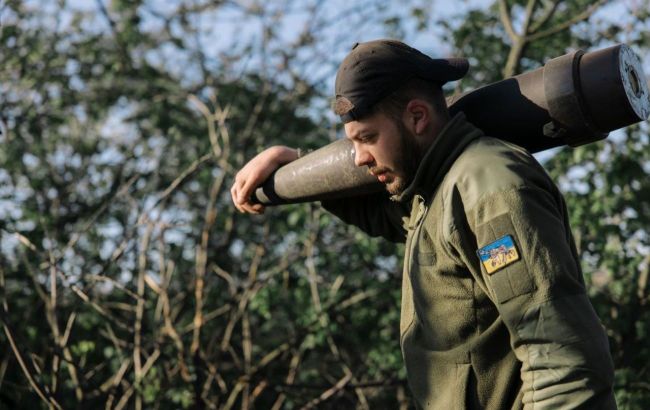Shells need powder: How world searching for 'scarce product' and why Ukraine needs cotton for this
 Photo: Ukraine needs its own gunpowder for ammunition production (t.me/ZSU45OABr)
Photo: Ukraine needs its own gunpowder for ammunition production (t.me/ZSU45OABr)
Against the backdrop of a chronic shortage of shells, Ukraine is increasing its production of munitions. But the key problem remains the lack of gunpowder, which is also typical for European partners who cannot dramatically increase supplies to deter Russia.
For more details on the deficit, the main suppliers of raw materials for gunpowder, and why cotton cultivation is being revived in Ukraine, see the article on RBC-Ukraine.
Contents:
- How gunpowder is obtained and who supplies the raw materials for its production
- How Russia increased nitrocellulose imports by almost twice
- Why European plans for projectiles could be thwarted by China
- How Ukraine is trying to obtain its raw materials for gunpowder
How gunpowder is obtained and who supplies the raw materials for its production
In modern weaponry, gunpowder is used as a propellant for bullets, artillery shells, and other types of ammunition. Take the example of an artillery shot - its components include the projectile, primer, casing, and powder charge. The latter is necessary to give the projectile the required initial velocity.
Therefore, gunpowder serves as an indispensable explosive substance. Its base is nitrocellulose, the best raw material for which is long-fibered varieties of hand-picked cotton.
In industrial production, it is also obtained from machine-picked cotton and wood cellulose. However, they contain significant impurities that complicate processing.
Nitrocellulose is obtained by treating purified, fluffed, and dried cellulose with a mixture of sulfuric and nitric acids.
Another important component of gunpowder is nitroglycerin. It is produced from glycerin, which is derived from propylene, itself obtained from gases formed during the high-temperature processing of petroleum. Besides these components, various stabilizers, catalysts, and so forth are used, but their quantity in comparison to nitrocellulose in gunpowder is very small.
In the third year of full-scale war, Ukraine and Russia are experiencing an "ammunition famine." Active combat has significantly depleted their ammunition arsenals, as well as the reserves of European countries supplying ammunition to Ukraine.
Currently, all of them are actively working to expand their defense industries, but much depends on the raw materials for gunpowder. This includes issues related to the distribution of nitrocellulose production.
China is the largest exporter, holding nearly half of the world market share. The United States follows with a quarter, then Spain and Uzbekistan with approximately 10% each.
Additionally, Chinese raw materials are cheaper compared to American and Spanish sources. Given China's geopolitical influence stemming from its share in the global market, it could play a significant role in determining the outcome of the arms race.
How Russia increased nitrocellulose imports by almost twice
Russia nearly doubled its nitrocellulose imports since 2022. According to March data from The Wall Street Journal, imports increased by 70% in the year of full-scale invasion and surpassed 3,000 tons by mid-2023, nearly doubling the 2021 levels.
The increase in shipments comes as defense companies worldwide struggle to procure this scarce raw material, leading to price hikes and production challenges. Nitrocellulose is subject to strict international trade rules and its production is limited to only a few countries.
With insufficient domestic supply for artillery powder, Russia's ability to procure it abroad plays a crucial role in its war efforts against Ukraine, as reported by WSJ citing analysts and US officials.
"The nitrocellulose that goes into the propellant becomes an artillery shell. The majority of battlefield deaths and a lot of the civilian collateral damage is from artillery," Wall Street Journal quoted Bradley Martin, senior scientist at RAND Institute.
After the United States and the European Union imposed sanctions on raw material supplies to Russia, imports from China sharply increased. However, suppliers also include companies from the United States, Germany, and Taiwan.
Before the invasion, Turkiye's share of supplies to Russia was less than 1%, but by mid-2023, a small Turkish company, Noy, accounted for nearly half of the imports. It purchased at least 80 tons of nitrocellulose from German subsidiaries of International Flavors & Fragrances (New York, USA).
In February, the US Treasury introduced new sanctions aimed at tightening control over suppliers and companies from third countries willing to provide Moscow with resources to support the military industry. Nitrocellulose had earlier been added to the list of high-priority controlled items, restricting their export.
In April, Japan banned shipments of raw materials for powder, and in June, Taiwan imposed similar sanctions against Russia. According to China's customs authorities, from 2015 to 2021, there were virtually no exports of nitrocellulose to Russia. However, the trend changed, with Beijing supplying over 700 tons in 2022, 1,300 tons in 2023, and 110 tons in the first quarter of 2024.
While China exports to other countries as well, its supplies to Russia have raised concerns in the US Recently, White House Senior Director for European Affairs Michael Carpenter referred to Beijing as "to some extent" Moscow's partner, particularly noting the export of nitrocellulose for powder production, which enhances security threats to Ukraine and Europe.
Additionally, imports from Kazakhstan and Uzbekistan have increased significantly. Typically, private Russian companies purchase cotton cellulose and then resell it to powder plants, although direct contracts also occur. According to BBC, after the start of the full-scale war, the Fergana Chemical Plant (Uzbekistan) increased deliveries to the Kazan Powder Plant by 25 times compared to 2019. Raw Materials Cellulose, an exporter, sent over $3 million worth of raw materials during 2022-2023. As for Kazakhstan, since 2022, Russian powder plants have been supplied with raw materials by the company Khlopokprom-Cellulosa.
Why European plans for projectiles could be thwarted by China
The Russian-Ukrainian war has exposed issues with Europe's defense industry capabilities, which have suffered from decades of underfunding. The main problem lies in the critical shortage of powder, preventing rapid expansion of projectile production, as reported by the Financial Times.
"A new artillery factory is very easy, but how to produce more artillery projectiles without raw materials? It’s not possible to increase, in a short time, nitrocellulose (production)... In Europe, there are no important producers of the raw materials we need. If I want to increase production of gunpowder I need probably three years," noted Jiří Hynek, chair of the Defence and Security Industry Association of Czechia.
Czech conglomerate Explosia, one of the largest suppliers of explosives for ammunition production, stated that its powder lines are operating at full capacity and expansion is not planned until 2026.
Spanish manufacturer FMG has also been operating at full capacity since autumn 2022, with its 155 mm projectiles being supplied to Ukraine. According to CEO Antonio Caro, the expansion will take up to six months due to difficulties with powder components. The cost of essential materials has increased by 2-3 times, leading to a price hike to €850 per projectile, approximately 20% higher than before 2022.
Currently, Europe receives powder from only a few countries. Therefore, the European Union is negotiating raw material supplies from the United States and Australia. New suppliers are needed because high dependence on cotton cellulose from China threatens the ability to expand projectile production.
As stated by Armin Papperger, CEO of German company Rheinmetall, China supplies over 70% of Europe's powder raw materials.
"There is a risk (that China could withhold linters for geopolitical reasons). And that is the reason why we buy as much as possible to fill our stocks," he added.
The EU aims to increase projectile production to 1.4 million units per year. This is to replenish their depleted stocks and assist the Armed Forces of Ukraine. However, the overall nitrocellulose deficit could pose a hindrance, as reported by the FT.
The largest importers in Europe are Germany, Sweden, and Belgium. Swedish company Saab stated that they currently have no supply chain issues, but dependency on China poses an elevated risk for the future. In the long term, they may consider obtaining wood cellulose, but this production line has not yet been launched, the conglomerate added.
According to Saab's CEO Micael Johansson, nitrocellulose is an example of how defense companies will need to establish new logistics in a multipolar world, where "not only the Western rules-based order will be present."
Rheinmetall confirmed that it is considering launching a nitrocellulose line as part of a new ammunition production facility in Lower Saxony. According to Papperger's estimates, the purchased Chinese raw materials should suffice for three years.
How Ukraine is trying to obtain its raw materials for gunpowder
There was no complete cycle of ammunition production in Ukraine; the military-industrial complex critically depended on powder supply. Factories that assembled ammunition found themselves in occupied territories after 2014. Last year, the then-Secretary of the National Security and Defense Council Oleksiy Danilov lamented the lack of established powder production.
Although attempts to grow cotton in southern Ukrainian regions were made. On an industrial scale - since the 1930s. But the yield was five times lower than in the Central Asian republics of the USSR, and from the second half of the 1950s, cotton cultivation was abandoned. As the specialized portal Latifundist writes, cotton was harvested in November-December, after which it ripened further.
According to Vira Borovyk, Senior Researcher at the Institute of Climate-Oriented Agriculture of the National Academy of Agrarian Sciences, the culture is undemanding to arid climates, and cotton can be successfully grown in the steppes in southern Ukraine.
In May, the Verkhovna Rada adopted a law on cotton. As noted by one of its co-authors, MP Stepan Cherniavskyi, the law aims to stimulate cotton cultivation. According to him, the defense sector's need for cellulose is 10,000 tons. And to meet this volume, it is necessary to sow 30,000 hectares of cotton.
As stated in the explanatory note, the registry contains information only about two varieties. Domestic breeding cannot offer adapted varieties that would meet the highest standards of raw materials for gunpowder. The new law will allow the registration of new varieties, including genetically modified ones. Previously, registration of conventional cotton took 2-3 years, and GM cotton was prohibited.
According to Borovyk's opinion, taking into account the appropriate climate and available resources in Ukraine, it is possible to create a complex in the short term to supply the industry with this category of product. For this purpose, the launch of cotton factories is necessary, where the producer will implement raw cotton. The implementation of fast-maturing varieties and processing technologies in perspective will provide cellulose not only for Ukraine's needs but also open opportunities for export.
The first cotton fields were sown back in May. It was reported that five experimental varieties would be attempted to grow in the Odesa region. Modern varieties have come from Germany, the USA, and Turkiye.
As reported by the Department of Agricultural Policy of the Odesa Regional State Administration, breeders are confident that favorable conditions for cotton cultivation have formed in southern Ukraine, especially in drought-prone areas. As of May, about 10 enterprises have expressed their willingness to sow small experimental fields to determine whether cotton cultivation is profitable and whether there is economic potential. In June, the department showcased a video with the first sprouts of Ukrainian cotton.
"After testing the mechanism... the areas could significantly increase. Farmers must first understand the technology of growing this crop and establish internal processing," said the initiator of the law, MP Cherniavskyi.
At a December meeting with defense representatives, President Volodymyr Zelenskyy stated that weapon and military equipment production had tripled, with an increase in ammunition production. In 2024, Ukraine will focus, among other things, on powder and explosives. From this perspective, domestically produced cotton cellulose could be a step towards a complete cycle of ammunition production.
Sources: materials from The Wall Street Journal, Financial Times, BBC, the Ukrainian agrarian portal Latifundist, the text of the law on expanding cotton varieties in Ukraine, and information from the Department of Agricultural Policy of the Odesa Regional Military Administration.

